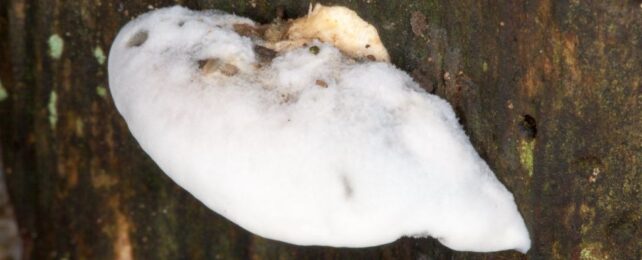The bitter bracket fungus, Amaropostia stiptica, is probably not available at your local farmer's market, and if you didn't get the hint from its name, it's because it tastes really, really terrible.
In fact, this bracket fungus is so bitter that a team of gustatory physiologists and biochemists felt they should take a closer look at its molecular makeup, in the hope it could help us understand why bitter taste exists in the first place.
They encountered three previously unknown bitter compounds, one of which may be the most potently bitter substance ever encountered. It's called oligoporin D, and it activated the human bitter taste receptor TAS2R46 at concentrations so low you could probably detect just a pinch of the stuff if it had been dissolved in an Olympic swimming pool.
The three compounds were tested on lab-grown tasting cells, and each was found to activate at least one of the 25 varieties of human bitter taste receptors.
Taste receptors on our tongues (or rather, the signals they send to our brains) can convince us to spit out particularly bitter substances – even though our species tends to rise to such challenges, learning to love what would deter other creatures.
This has led scientists to assume that bitter tastes exist to deter us from eating things we shouldn't, although there are so many exceptions that the theory is becoming increasingly tenuous.
The bitter bracket fungus, for instance, is "of no gastronomic interest", but it's not actually poisonous. The deathcap mushroom (Amanita phalloides) can be lethal, but by all accounts, it apparently tastes quite nice.
"However," the authors point out, "humans are not the primary predator of mushrooms; numerous other vertebrates and invertebrates consume them, and their receptors may be tuned to separate toxic from nontoxic mushrooms better."
To add to the confusion, these so-called 'taste' receptors are found in other parts of the human body, including your colon, stomach, and even your skin. They serve very different functions there.
"The more well-founded data we have on the various bitter compound classes, taste receptor types and variants, the better we can develop predictive models using systems biology methods to identify new bitter compounds and predict bitter taste receptor-mediated effects," says Maik Behrens, food systems biologist at the Technical University of Munich in Germany.
"This applies to both food constituents and endogenous substances that activate extra-oral bitter taste receptors."
The bitter bracket fungus may not have answers for us just yet, but its tongue-curling flavor should help lead the way. It's filling a fungi-shaped gap in our databases of bitter tastes, which are full of molecules from flowering plants and chemistry laboratories, yet contain very little representation from the animal, bacterial, and fungal kingdoms.
It's important to diversify those records to include more ancient substances if we want to understand the purpose of bitter taste receptors: they evolved over 500 million years ago, while flowering plants and human chemists are relatively modern, around 200 million years and a few centuries old, respectively.
"Our results contribute to expanding our knowledge of the molecular diversity and mode of action of natural bitter compounds," says Behrens.
"In the long term, insights in this area could enable new applications in food and health research, for example in the development of sensorially appealing foods that positively influence digestion and satiety."
And before you go daring your friends to take a lick of Amaropostia stiptica, please remember that there may be poison lookalikes out there. Best to keep your own taste receptors far from unidentified fungi.
The research was published in Journal of Agricultural and Food Chemistry.
